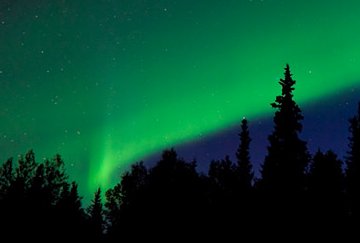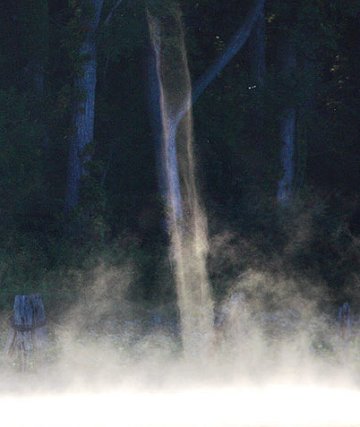| LUNAR PERSEIDS: Amateur astronomers watching last month's Perseid meteor shower saw meteoroids hitting not only Earth but also the Moon. The impacts, which they recorded using backyard telescopes and off-the-shelf video cameras, are featured in today's story from Science@NASA. BREWING STORM: Last night (Sept. 2nd) in North Pole, Alaska, the sky turned green. "I didn't expect to see any Northern Lights, but there they were," says Bud Kuenzli, who opened the shutter of his Canon EOS 1D for 15 seconds and collected this photo: 
In Alaska, this counts as a mild display, but it might herald a bigger show in the nights ahead. A solar wind stream is approaching Earth, due to hit late on Sept. 3rd or Sept. 4th. High-latitude sky watchers should be alert for auroras. August 2008 Aurora Gallery
[Science@NASA: Plasma Bullets Spark Northern Lights] STEAM DEVILS: Steam devil season is underway. In late summer-early fall when waters are still warm but morning air is growing cold, little tornadoes of steam are often seen dancing across lake surfaces. Iowa photographer Mike Hollingshead caught this one at sunrise on August 29th: 
"I saw these amazing devils on a small lake near DeSoto Bend," he says. "The rapid motion in them can be rather captivating if you can get a close enough view; my 400mm lens did the trick." Steam devils appear when vapor released by a warm lake condenses rapidly in cooler air above. Light winds spin condensing plumes of steam into dancing columns. The bigger the lake, the bigger the devils. Steam devils on Lake Superior have been observed to rise 1500 ft tall! "These steam devils really seem to prefer the morning shadow line of some trees along the lake shore," notes Hollingshead. "Differential heating must help them get started there." The devilish fog also provided a photogenic backdrop for the crescent Moon and created a crepuscular corona around the sun: photos. "This is a good time of year to wake up early." | 
